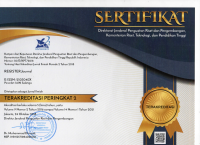The Adjacency Pairs Analysis of Teacher Students Talks in Hearing Impairment Classroom
Abstract
ABSTRACT
The purpose of this study is to investigate the components of adjacency pairs which appear in a conversation between an English teacher and hearing-impairment students in a special need classroom. Another aim is to find the dominance of English teacher in the special need classroom. Data are collected from a classroom observation, recording and transcribing their conversation during the teaching and learning activities in English classroom. Meanwhile, data analysis is carried out by identifying, analyzing and classifying based on Mc Charty’s theory of adjacency pairs., It is then found that there are 9 kinds of adjacency pairs committed from the interaction between English teachers and the hearing-impairment students as follows: (1) Compliment / Acceptance, (2) Information / Acknowledgement, (3) Greeting / Greeting, (4) Invitation / Acceptance, (5) Offer / Refusal, (6) Question / Answer, (7) Summons / Answer, (8) Accusation / Denial, (9) Offer / Acceptance. This study reveals a fact that various adjacency pairs occur in the special need classroom even though the teacher’s role is also quite powerful in the special need classroom. The finding of this study may become the reference for the teachers and practitioners who need deep understand toward characteristics of the special needs students especially for the impairment students.
Keywords: Adjacency Pairs, Teaching and Learning, Hearing-impairment Students
Full Text:
PDFReferences
REFERENCES
Baiat, G.E., Coler, M., Pullen, M., Tienkouw, S., & Hunyadi, L. (2013). Multimodal analysis of “well” as a discourse marker in conversation: A pilot study. Paper presented at 4th IEEE International Conference on Cognitive Infocommunications, Budapest, Hungary.
Coates, J. (2004). Women, men, and language: A sociolinguistic account of gender differences in language (2nd ed.). London, UK: Longman.
Fauziati, Endang. (2016). Principles of Foreign Language Teaching, Learning, and Researching. Surakarta: Era Pustaka Utama.
Hagoort, P., & Meyer, A. S. (2013). What belongs together goes together: The speaker-hearer perspective. a Commentary on Macdonald’s PDC Account. Frontiers in Psychology, 4, 228.
Hasanuddin WS. (2016). The intangible cultural heritage of Minangkabau traditional expressions: The local wisdom of the society in advising and noble advicing. Humanus, 15(2), 131-141.
Hashamdar,Mohammad. (2012). The teacher- student communicstion pattern: a to follow. Islamic Azad University Karaj Iran.
Heri, Mudra. (2018). Adjacency pairs as uttered in the conversations of Sofia Coppola’s lost in translation movie script. Humanus: Jurnal Ilmiah Ilmu-ilmu Humaniora, Volume 17, pp,126-137(12).
Huntington, A., & Watton, F. (1986). The spoken language of teachers and pupils in the education of hearing-impaired children. VoltaReview,88,5–19.
Isgianto, Lukman. (2016) The Adjacency Pairs Analysis On ‘Six Minutes English’ Conversation Script of BBC Learning English: A Study of Discourse Analysis International Seminar Prasasti III: Current Research in Linguistics.
Litchfield, S., & Lartz, M. N. (2002). Role analysis of teachers certified in teaching students who are deaf/hard of hearing who team-teach in co-enrollment classrooms. Teacher Education and Special Education, 25, 145–153.
Lovett, F. (2010). A General Theory of Domination and Justice. Oxford: Oxford University Press Inc
McCarty, M. (2002). Discourse Analysis for Language Teachers. New York: Cambridge University Press.
McCharty, Michael. (2000). Discourse analysis for language teachers. United Kingdom: Cambridge University Press.
McCharty, Michael. (2002). Discourse analysis for language teachers. United Kingdom: Cambridge University Press.
Miles, Matthew B., and A. Michael Huberman (1994).
Qualitative Research Design, second edition. Thousand Oaks CA: Sage Publications.
Moores, D. (1987). Educating the deaf: Psychology, principles, and practices. Boston: Houghton Mifflin.
Moores, D. F. (2001). Educating the deaf: Psychology, principles, and practices (5th ed.). Boston: Houghton Miffl in Company.
Musselman, C., Lindsay, P., & Wilson, A. (1988). An evaluation of recent trends in pre-school programming for hearing impaired children. Journal of Speech a Hearing Disorders, 53, 71–88.
Pineda, J. (2015). Classroom interaction: a dynamic of questions and answers. Enletawa Journal, 8 (2), 15 – 33.
Power, D., Hyde, M., & Leigh, G. (1996). Language of teachers of the deaf to hearing students and deaf students under simulated oral and simultaneous communication conditions. Journal of the Canadian Association of Educators of the Deaf and Hard of Hearing, 22,122–129.
Rajasekar, S., Philominathan, P., Chinnathambi, V. (2013). Research Methodology. Electronic address: rajasekar@cnld.bdu.ac.in.
Richards, J.C., and Schmidt, R. 1983. Conversational Analysis. In J.C. Richards and Schmidt (eds), Language and Communication. London: Longman.
Savage, R., Savage, J., Evans, L., & Potter, J. (1986). Language and reading development in profoundly hearing impaired children—Intelligence, learning and communication factors: A review. Current Psychological Research and Reviews, 5,62–73.
Schirmer, B. (1985). An analysis of the language of young hearing-impaired children in terms of syntax, semantics, and use. American Annals of the Deaf,130,15–19.
Seewald, R., Ross, M., Giolas, T &Yonovitz, A. (1985). Primary modality for speech perception in children with normal and impaired hearing. Journal of Speech and Hearing Research, 28,36–46.
Sivaranjani, Swathy, B., Nithiyanantham, S. (2015). Value of Understanding and Accepting for the Students of Professional Studies, Journal of Education and Practice, v6 n25 p117-126.
DOI: https://doi.org/10.18326/rgt.v12i1.81-99
Refbacks
- There are currently no refbacks.
Copyright (c) 2019
License URL: http://creativecommons.org/licenses/by-sa/4.0/











